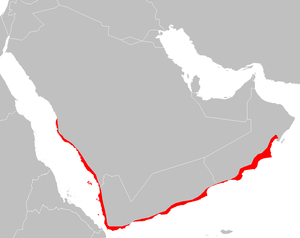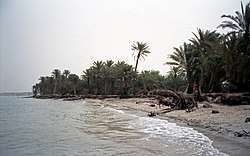Arabian Peninsula coastal fog desert
The Arabian Peninsula coastal fog desert, also known as the Southwestern Arabian coastal xeric scrub, is desert ecoregion on the southern coasts of the Arabian Peninsula, which experiences thick fogs where visibility may be reduced to 33 feet (10 m). It is classed as an Afrotropical fog desert [1]
| Arabian Peninsula coastal fog desert | |
|---|---|
 map of the Arabian Peninsula coastal fog desert | |
| Ecology | |
| Realm | Afrotropic |
| Biome | Deserts and xeric shrublands |
| Geography | |
| Area | 82,900 km2 (32,000 sq mi) |
| Countries | Oman, Saudi Arabia and Yemen |
| Conservation | |
| Conservation status | critical/endangered |
Location and description
This ecosystem exists on a strip along the western and eastern coasts of Arabia. It follows the coast of Oman southward from Masirah Island and reaches inland to 120 km in the Jiddat al Harasisi plateau and the Dhofar mountains. From here it continues as a very narrow strip (only 5 km wide) along the coast of Yemen and up the 50 km wide the Tihamah plain along the Red Sea coast of Saudi Arabia. In Oman and Yemen moisture is provided by thick fogs coming off the ocean during the summer khareef monsoon, while the hot Tihamah plain is moisturised by some rainfall and the generally high humidity of the Red Sea.
Flora
In this region, although it rarely rains the fog provides moisture sufficient to nurture a great deal of grassland, shrubs and thick woodland. There are over sixty local species of plant. This coastal strip is of particular importance as further inland where the fog does not have an influence most of the Arabian Peninsula is desert. Vegetation varies progressively away from the coast which features dense woodland of Anogeissus dhofarica, Acacia senegal and various thorny Commiphora trees and shrubs. The richest flora can be found in the Dhofar mountains which have 900 plants including 60 endemic species and two endemic genera, Cibirhiza and Dhofaria. One of these plants, the frankincense tree (Boswellia sacra) was a source of great wealth for Dhofar in antiquity. In Yemen the side of Jabal Urays facing the sea is covered with Euphorbia balsamifera shrubs.
Fauna
The many mammals found here include the Arabian oryx (Oryx leucoryx) which was reintroduced to the wild after disappearing, gazelles and the Nubian ibex, a goat antelope. Predators found on the coast include caracals, Arabian wolf, striped hyena and the critically endangered Arabian leopard (Panthera pardus nimr), which survives on Jebel Samhan in the Dhofar mountains. The Arabian gazelle which once lived on the peninsula is now extinct.
Threats and preservation
The main threat to this ecosystem is overgrazing by increasing numbers of cattle and other livestock as well as off-road driving and human encroachment. Urban areas in this ecoregion include: in Oman the port of Duqm and the Dhofar capital of Salalah; in Yemen, the Hadhramaut port capital Mukalla, the former capital and ancient port of Aden, the Red Sea coffee ports of Al Hudaydah (still the largest town on this coast of Yemen) and Mocha, and the World Heritage Site of Zabid; and the city of Jizan, the fruit basket of Saudi Arabia. Protected areas in Oman include the controversial Arabian Oryx Sanctuary where the reintroduction took place, and Jabal Samhan Nature Reserve established for the protection of the leopards. There are a number of Important Bird Areas on the coast of Yemen but none are officially protected.[2]
References
- World Wildlife Fund, ed. (2001). "Arabian Peninsula coastal fog desert". WildWorld Ecoregion Profile. National Geographic Society. Archived from the original on 2010-03-08.
- "Arabian Peninsula coastal fog desert". Terrestrial Ecoregions. World Wildlife Fund.
